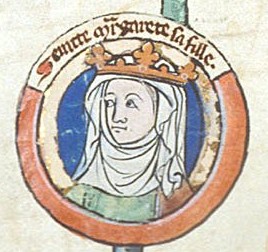Saint Margaret of Scotland
Feast Day: November 16
Saint Margaret used her status as queen to promote Christianity. She founded several churches and her private life was devoted to prayer. She was the mother of 8 children. Margaret’s uncle was St. Edward the Confessor.
Born about 1045, died 16 November 1093, was a daughter of Edward “Outremere”, or “the Exile”, by Agatha, kinswoman of Gisela, the wife of St. Stephen of Hungary. She was the granddaughter of Edmund Ironside. A constant tradition asserts that Margaret’s father and his brother Edmund were sent to Hungary for safety during the reign of Canute, but no record of the fact has been found in that country. The date of Margaret’s birth cannot be ascertained with accuracy, but it must have been between the years 1038, when St. Stephen died, and 1057, when her father returned to England. It appears that Margaret came with him on that occasion and, on his death and the conquest of England by the Normans, her mother Agatha decided to return to the Continent. A storm however drove their ship to Scotland, where Malcolm III received the party under his protection, subsequently taking Margaret to wife. This event had been delayed for a while by Margaret’s desire to enter religion, but it took place some time between 1067 and 1070.
In her position as queen, all Margaret’s great influence was thrown into the cause of religion and piety. A synod was held, and among the special reforms instituted the most important were the regulation of the Lenten fast, observance of the Easter communion, and the removal of certain abuses concerning marriage within the prohibited degrees. Her private life was given up to constant prayer and practices of piety. She founded several churches, including the Abbey of Dunfermline, built to enshrine her greatest treasure, a relic of the true Cross. Her book of the Gospels, richly adorned with jewels, which one day dropped into a river and was according to legend miraculously recovered, is now in the Bodleian library at Oxford. She foretold the day of her death, which took place at Edinburgh on 16 Nov., 1093, her body being buried before the high altar at Dunfermline.
In 1250 Margaret was canonized by Innocent IV, and her relics were translated on 19 June, 1259, to a new shrine, the base of which is still visible beyond the modern east wall of the restored church. At the Reformation her head passed into the possession of Mary Queen of Scots, and later was secured by the Jesuits at Douai, where it is believed to have perished during the French Revolution. According to George Conn, “De duplici statu religionis apud Scots” (Rome, 1628), the rest of the relics, together with those of Malcolm, were acquired by Philip II of Spain, and placed in two urns in the Escorial. When, however, Bishop Gillies of Edinburgh applied through Pius IX for their restoration to Scotland, they could not be found.
Patronage
Service to the poor
Source: Catholic Encyclopedia

Birthplace
Born
AD 1045
Kingdom of Hungary
Death
16 November 1093
Edinburgh, Kingdom of Scotland
Canonized
1250 (Pope Innovent IV)
Shrine/Relics/Tomb
Fife, Scotland
Learn more:
Simply Catholic
St. Margaret of Scotland: A saint for service to the poor – SimplyCatholic.com
St. Margaret would perform charitable acts for the poor. In loving and honoring them, she was loving and honoring Christ…
Franciscan Media
Saint Margaret of Scotland – FranciscanMedia.org
Margaret of Scotland was a truly liberated woman in the sense that she was free to be herself. For her, that meant freedom to love God and serve others.…
